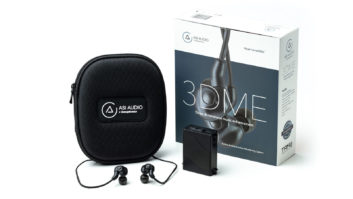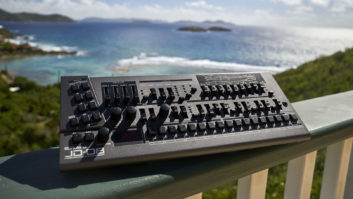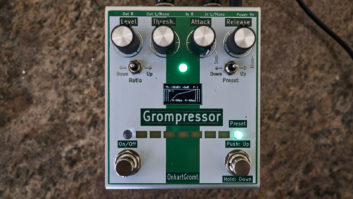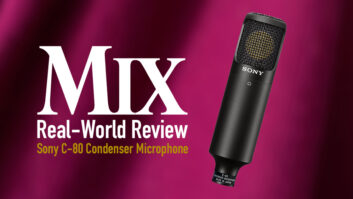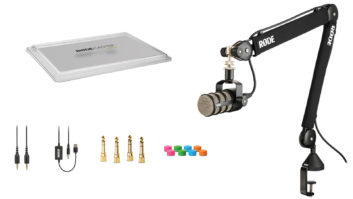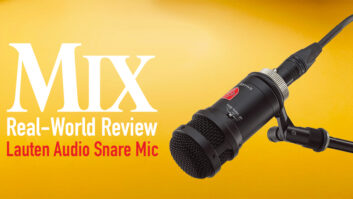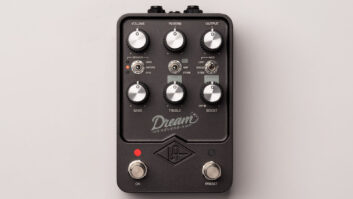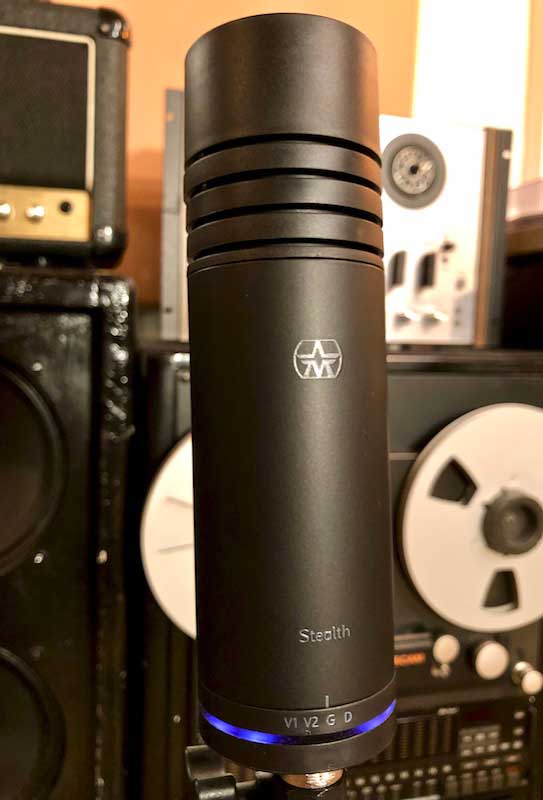
I’ve been searching to no avail to find a clever and memorable way to summarize the Stealth from Aston Microphones, but I cannot, as it is so complex. It’s as if Aston took a number of modern mic trends, expanded on them and cleverly rolled them into one multifaceted product. Take the modern preference for big, bold dynamics (from mics such as Shure SM7s and Electro-Voice RE20s) among podcasters, indie crooners and metal screamers alike. Take the modern technique of adding pre-preamp gain, like a Cloudlifter or dBooster, to the aforementioned low-output mics. Take the modern mic design concept of multiple signal paths for tonal/response variations, as has been employed by Lauten and Roswell. Take all these concepts, roll them into one stylish, forward-thinking model and you’ve got the Stealth.
Stealth ($499 list, $399 street) is a moving coil, dynamic, cardioid-only, end-address mic that can handle the high SPLs of drums, electric guitar amps and screaming vocalists. Optionally, an auto-detect circuit senses 48 V phantom power and engages an active class-A preamp with 50 dB of boost (an industry first). A purple ring illuminates near the Stealth’s base when active, although this light is defeatable with a push button on the mic’s base if you need to go “stealth” on a dark stage or TV shoot.
In either passive or active mode, Stealth has four voicing settings: Vocal 1, Vocal 2, Guitar and Dark. These voicings are the result of four unique analog signal paths—neither DSP nor simple EQ boosts. From Aston, “The voice settings are not EQ filters. They are contour networks, meaning the bulk of the signal does not pass through any sort of filter circuitry. The whole signal is slightly attenuated, with some frequencies being added back in at a higher level. This results in much lower phase distortion than conventional filter designs.” The tonal balances of these settings were chosen by an evaluation group of 92 engineers, who blind-tested their way into these source-idealized settings that offer versatility far beyond those four specific sources. Imagine a paintbrush with a rotatable four-way head and optional paint injection—labels don’t matter; pick whatever combination suits the job and start painting!
The Stealth capsule is mounted in a stainless steel Faraday cage, a metal mesh enclosure that distributes electromagnetic fields across the cage and reduces RF interference. This structure is suspended within the chassis by three Sorbothane hemispheres (the synthetic polymer Sorbothane is an efficient acoustic vibration damper), which isolates the assembly from the outside world and eliminates the need for a shockmount. The mic is stand-mounted via a unique quick-clip design that relies on precision machining of a slim 4 mm hard plastic shaft that simply pops in and out of the mic body. The base of the body houses a four-position rotary switch for selecting among the four voicings.
Performance is rated at 20 Hz to 20 kHz with +/-3 dB variation, self-noise at 10 dB A-weighted; sensitivity ranges from 1 mV/Pa in passive mode to 150 mV/Pa in active mode (averaged across all four voicings, as there are volume differences among them); and a maximum SPL of 140 dB yields 0.5 percent THD.
Over the course of a few months, I tried the Stealth on just about every session I had, as there was always an application that seemed appropriate, and yet I didn’t get to try it on every combination I would’ve liked to. There are numerous possibilities if you consider that there are always eight options on board and ready to go (passive or active, in each of the four voicing modes), not to mention placement and preamp choices.
In Session
Stealth can handle a number of snare drum tasks with excellence. Snare top, passive revealed an output level a little lower than a SM57 placed in the same spot, with good balance in the Dark and (brighter) Vocal 1 modes and a touch of below 1 kHz midrange color for personality. There were nice results underneath on the wires, too, but Stealth’s size made for a tight fit. Even better was Stealth in the “snare-o’head” position (4 feet above, aimed straight down, Dark, active); there, its tight pattern rejected enough cymbals for some useful punchy tones and more air than you get up close. I found the active mode to be plenty hot, requiring almost no preamp gain or a pad in many cases.
It seems that I record tambourine overdubs constantly, using anything from a ribbon to a dynamic to a condenser mic, and I am never completely happy with the results. Here, I absolutely loved the Stealth in Dark Mode and passive, where the tone was simply perfect—no EQ and even without compression, it sat in the mix politely and beautifully.
I tried the Stealth on a couple of acoustic guitar tracks and found it very nice active and in Guitar Mode, with plenty of detail and a refined top end, but the midrange wasn’t quite to my liking (nor were the Vocal modes). There was just a little too much midrange color and personality, but that’s perhaps a personal preference; Stealth is quite capable on stringed instruments with low self-noise, ample active gain and directionality to reject heavy-breathing wheezers (and it’s possibly useful on overly bright guitars in Dark mode).
Conversely, I really liked Stealth on just about anything I could run through a guitar amp: electric guitars, acoustic guitars, electric mandolin (through a cranked JCM800 nonetheless!), Fender Rhodes, harmonica, synthesizer, you name it. Every one of them sounded absolutely great with the Stealth (Guitar mode, passive). That little bit of midrange color I obsessed over was helpful with definition and clarity on all of the above.
It’s on vocals that I wish I had much more time to explore the myriad possibilities. Suffice to say, I found plenty of useful tones, once again across the entire spectrum. For straight-up, typical LDC-type vocals, I found myself on Vocal 1 or 2 modes, with the active boost necessary to sweeten the top, increase sensitivity and create that “condenser-ness.” I found Vocal 2 typically too bright, but a welcome option, even if Guitar was too mid-emphasized and Dark a bit too murky.
I especially liked the Guitar setting (active) on rap ad-lib vocals, where the focused mids and genteel high end were ideal for aggressive HPFing and FX processing. For loud-as-hell screamers, the passive mode brought that traditional dynamic mic sound that is “tone du jour” today, in either the Vocal 1 or in the Dark mode for the scratchiest and thinnest vocalists.
Despite the wealth of versatility and wildly useful tones, the Stealth isn’t exactly easy to put to use. First of all, end-address designs aren’t convenient to get in certain positions, and Stealth is large—similar to a RE20, 320 or SM7—so you’ll need ample room. Stealth’s stand adapter connects and disconnects neatly, but it is only just up to the task of holding the mic in a horizontal position (it is 1.5 pounds, after all). I had to tighten it to the point of hand pain and it felt like the adapter was on the verge of breaking before it held firm, and then sometimes it still sagged. That stand adapter leaves a tight fit for the mic cable on the butt end of the mic; some larger cables didn’t quite fit, although most were fine.
I had a little trouble changing modes with the rotary mode switch. Aston has wisely added safety features that make it impossible to accidentally bump the switch out of position, but often I would have to rotate the switch repeatedly until I landed on my desired setting. Sure enough, it seemed to loosen up over repeated use, but I still wish the switch had some texture for traction, or maybe a notch for a small screwdriver.
There are some applications I think Stealth would excel at, even if I didn’t get to try them myself. Podcasters often praise SM7 and RE20 mics, but complain of the high gain needed and the subsequent noise floor with their often marginal interfaces. Stealth offers a flexible option in active mode when less gain and more detail is desired, or in passive mode if mouth noises (clicks and pops) are an issue. Some people love MD421s and RE20s on kick drum and bass guitar; here, Stealth could provide that dynamic punch in passive and Dark modes, and present an option with a quite different midrange character (sometimes essential in getting low-frequency instruments to cut through crowded mixes).
The Final Mix
Stealth delivers the versatility promised. The internal shockmounts work well, as I never encountered any thumps or low-frequency disturbance. The Faraday cage and pop filter ensured I didn’t encounter noise interference or issues with plosives (okay, some metal screamers could use an external pop filter). The active preamp circuitry, too, delivers not only clean, convenient gain, but also an increase in detail and presence. Finally, the four voicing modes achieve not only a wide sonic palette, but also niche specificity, as the Guitar mode delivers a certain amount of magic that seems to benefit all kinds of guitars and guitar-like things. V1 was my clear favorite, as V2 was too bright and strident for many jobs. The Dark setting isn’t as ribbon-y as suggested, but it does offer the best bass response and a rolled-off top end for when a subdued response is required.
Stealth may not be the easiest mic to set up and use in a session, but it sounds great, offers groundbreaking features, can handle almost any assignment under the sun, and costs less than $500. That earns a strong recommendation for utility-seeking first-timers, those growing their mic collections on a budget, and those with big, expensive collections looking for that post-modern advantage of versatility.
Aston Microphones • www.astonmics.com

